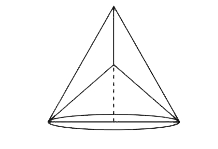The central hollow portion of vertebra is
Neural canal
Central canal
Auditory canal
Vertebro-arterial canal.
The correct Answer is:A
Step-by-Step Text Solution:
1. Understanding the Structure of the Vertebra: The vertebra is a complex structure that forms part of the vertebral column, which protects the spinal cord and supports the body.
2. Identifying the Parts of the Vertebra: The vertebral column is divided into several regions:
- Cervical region (neck area)
- Thoracic region (chest area)
- Lumbar region (lower back)
- Sacral region (base of the spine)
- Coccyx (tailbone)
3. Recognizing the Function of the Vertebra: The primary function of the vertebrae is to provide support and protection for the spinal cord, which runs through the vertebral column.
4. Locating the Central Hollow Portion: Within each vertebra, there is a central hollow area that is crucial for housing the spinal cord.
5. Naming the Central Hollow Portion: This central hollow portion of the vertebra is referred to as the "neural canal" or "spinal canal." It is specifically designed to encase and protect the spinal cord as it extends from the brain.
6. Eliminating Incorrect Options:
- The "auditory canal" is related to the ear and not the vertebra.
- The "central canal" does not refer to the vertebra specifically.
- The "vertebro-arterial canal" pertains to arteries and is not the correct term for the hollow portion of the vertebra.
7. Conclusion: Therefore, the central hollow portion of the vertebra is known as the neural canal or spinal canal.
- Cervical region (neck area)
- Thoracic region (chest area)
- Lumbar region (lower back)
- Sacral region (base of the spine)
- Coccyx (tailbone)
- The "auditory canal" is related to the ear and not the vertebra.
- The "central canal" does not refer to the vertebra specifically.
- The "vertebro-arterial canal" pertains to arteries and is not the correct term for the hollow portion of the vertebra.
Topper's Solved these Questions
- BOOK - DINESH PUBLICATION ENGLISHCHAPTER - LOCOMOTION AND MOVEMENTEXERCISE - CHECK YOUR GRASP10videos
LOCOMOTION AND MOVEMENT
- BOOK - DINESH PUBLICATION ENGLISHCHAPTER - LOCOMOTION AND MOVEMENTEXERCISE - CHECK YOUR GRASP10videos
LOCOMOTION AND MOVEMENT
- BOOK - DINESH PUBLICATION ENGLISHCHAPTER - LEAFEXERCISE - CYG10videos
LEAF
- BOOK - DINESH PUBLICATION ENGLISHCHAPTER - MAMMALIA [MAMMA - BREAST]EXERCISE - Brain Teasers - I100videos
MAMMALIA [MAMMA - BREAST]
Similar Questions
Knowledge Check
- Question 1 - Select One
Many portions of the central nervous system exert control over the autonomic nervous system. Major control and integration of the autonomic nervous system occurs in what portion of the brain :
Abrain stemBcerebral cortexCcerebellumDhypothalamus
The correct order of vertebrae is
View SolutionA uniform solid right circular cone has its base cut out in conical shape shown in figure such that the hollow portion is a right circular cone on the same base. Find what should be the height of the hollow portion so that the centre of mass of the remaining portion may coincide with the vertex of the hollow portion.
 View Solution
View SolutionThe total number of vertebrae in man is ........
View SolutionThe centrum of a vertebra which is concave on both sides is called
asView SolutionPith is hollow in
View SolutionTotal number of vertebrae in frog is
View SolutionTotal number of vertebra in Man :−
View Solution

